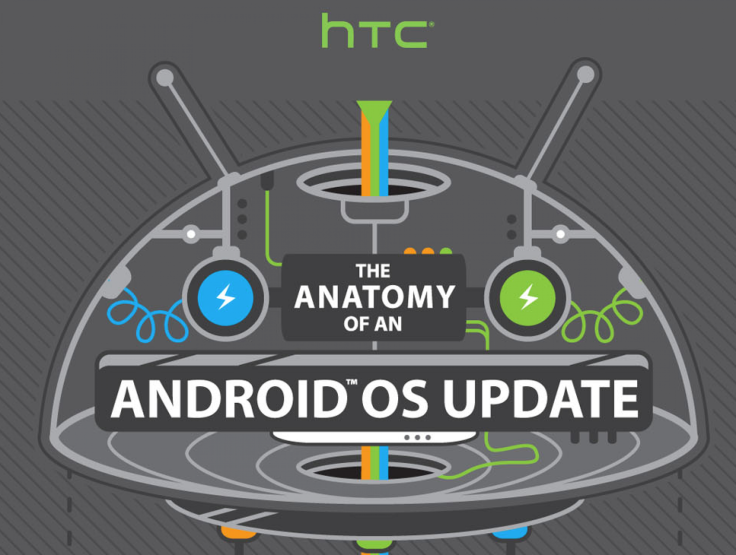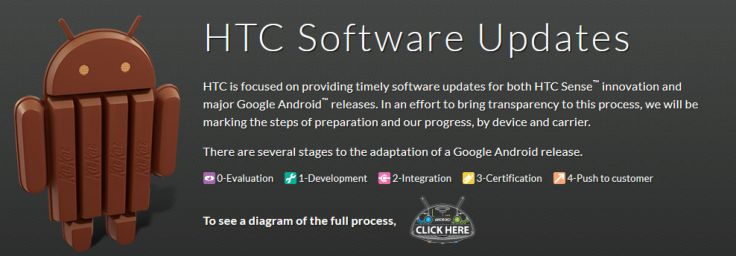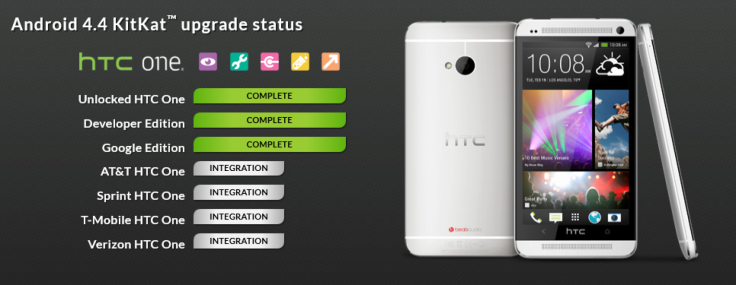Android 4.4 KitKat Release Date Explained: HTC Infographic Details ‘The Anatomy Of An Android OS Update’

The increasingly transparent HTC is once again informing the public about its plans for providing its devices with system support. This time, the Taiwanese manufacturer has revealed the inner workings of an Android OS update in a detailed infographic.
Android fans may wonder why it takes so long for OEMS to release the latest system updates, compared to Google-branded devices that update almost immediately. It often takes several months for OEMs to corroborate with the carriers powering their devices to have and updated rollout. By the time devices begin to update to a particular Android version, Google usually has time to release yet another new version of Android, which means devices are rarely outfitted with the latest software once they update.
Some devices, such as unlocked models and the Google Play Edition models, which were introduced by several different carriers this year, have an easier time updating, for various reasons. In its infographic, HTC lays out the process that goes into updating the HTC One to Android 4.4 KitKat.

According to HTC, the release of an Android update happens in four stages: Evaluation, Development, Integration, Test/Certification, and Push to Customer. During Evaluation (counted as stage zero), Google sends its system PDK to OEMs prior to the announcement of their next operating system. OEMs then assess system requirements with their current devices. During Development, chipset makers, who provide the latest internal specs for devices, release drivers and optimizations in the form of a “modified board support package (BSP).” This ensures that the device’s hardware is compatible with the upcoming software. During Integration, OMEs add their own branded software to the latest Android system. HTC for example, would add its latest Sense UI. In addition, carriers will add their own apps, services and requirements to the new Android system. During Test/Certification, OEMs submit their software builds for Lab Entry to be tested for bugs. If bugs are found, a new build with fixes will be released. Carrier branded models are also subject to testing by their respective networks. During Push to Customer, Google gives each new system build its Technical Acceptance, after which OTA updates begin. OEMs roll out updates for their unlocked and developer edition models, while Google rolls out updates for Google Play Editions, and carriers roll out updates for their respective models.

Notably, as the HTC One Google Play Edition (and similar devices) runs Google’s stock Android, it gets to skip a few steps and goes directly to testing and certification upon the release of a new Android system. Many will remember that HTC delivered its code for the HTC One Google Play Edition to Google within 15 days of the Android 4.4 release, the device updated not long after. The HTC One unlocked model and HTC One Developers Edition have also received their Android 4.4 updates as HTC doesn't have to work with any carriers to complete their development.
Meanwhile, carrier-branded HTC One models for AT&T, Sprint, T-Mobile and Verizon are still in the middle of the update process. According to HTC, carrier-branded models are currently in the integration step of the update process, meaning that the manufacturer is currently adding its latest software to the Android 4.4 KitKat system. U.S. HTC One models are expected to update with the Sense 5.5 UI. Additionally, carriers may also be adding their own firmware to the update. Upon the release of Android 4.4 KitKat, HTC announced that carrier models will likely begin updating in late January. With the release of this infographic, it appears to some that HTC may be veering off course with is updating timeline. It seems as if the Android 4.4 update progress for carrier-branded models is still in the early stages for an update expected in just one month. Keep in mind that despite HTC announcing its late September release for the previous Android 4.3 Jelly Bean on the HTC One, carrier models in particular did not begin updating until October; the Verizon HTC One just recently updated to Android 4.3 last week. Fans and pundits wonder if the Android 4.4 update will see similar rollout delays, which are often caused by hold ups in carrier testing, many carriers explain.
There's no telling how the Android 4.4 update for the HTC One will pan out, but hopefully, the Taiwanese manufacturer will continue to keep customers in the know.
Did you find HTC’s Android OS update infographic helpful? Let us know in the comments below.
Follow me on Twitter @FionnaatIBT.
© Copyright IBTimes 2024. All rights reserved.





















